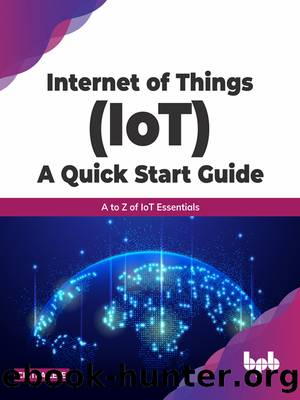Internet of Things (IoT) A Quick Start Guide: A to Z of IoT Essentials by Chitra Lele

Author:Chitra Lele [Lele, Chitra]
Language: eng
Format: epub
Publisher: BPB Publications
Published: 2022-08-15T00:00:00+00:00
Spotlight
The marriage of IoT and ECM will lead to the growth of more and more connected enterprises, and this combination will enhance the capabilities of such enterprises to manage and analyze unstructured, structured data scenarios. This combination will lead to the development and deployment of novel use cases.
Edge computing is one step ahead of the cloud. Gartner (it is a technology research and consulting company) defines edge computing as âa part of a distributed computing topology in which information processing is located close to the edgeâwhere things and people produce or consume that information.â It is computing that is done at or near the source of the data in terms of content collection, processing, and delivery (whereas the cloud involves multiple data centers). The main aim of edge computing is to reduce network congestion and latency by keeping the traffic local. Making the entire edge computing infrastructure intelligent is where technologies such as IoT, AI, and more, come into the picture. In turn, edge computing and its advantages act as a cost-effective enabling factor for implementing new IoT use cases and initiatives. More and more new applications of IoT arising on the tech horizon continue to drive edge computing as it provides real-time computing power and reduces bandwidth requirements to a considerable degree.
The main reason why the edge has become so popular is because of its âintelligentâ aspect, which opens up a whole new set of opportunities. The advantages of switching from âdumbâ to âintelligentâ edge computing architectures include reduction in cost and increase in functionality, agility, usability, scalability, and flexibility.
IoT gateway platforms are needed to centralize and preprocess the data derived from IoT devices/sensors at the edge level. In the case of edge computing, IoT analysis and response to findings becomes faster as all this is done where a data source or physical IoT device or sensor actually exists. Such platforms provide an interoperable, secure, compatible, and scalable channel for remote device management, as they have several features such as device authentication, data preprocessing, edge analytics, fault detection, timely diagnostics, and so on. The new generation of gateways is far superior and intelligent. Some of the popular platforms include Azure, AWS, and so on.
IoT benefits from having computing power closer to where a data source exists. In order for IoT data to be analyzed quickly so it can be used for rapid decision making, it needs to be analyzed at the edge, rather than transferring it back to a central location before it can be analyzed. An IoT device is a physical object that is connected to the Internet and is the source of the data being generated. An edge device is where the data is collected and processed.
IoT and edge computing can bring about a lot of advantages such as reduced data exposure, faster mitigation response, lesser security breaches, reduced bandwidth bottleneck, lesser network load, optimized performance, enhanced security measures, and so on. The biggest advantage of edge computing for IoT business applications is business continuity. As edge
Download
This site does not store any files on its server. We only index and link to content provided by other sites. Please contact the content providers to delete copyright contents if any and email us, we'll remove relevant links or contents immediately.
Exploring Deepfakes by Bryan Lyon and Matt Tora(7438)
Robo-Advisor with Python by Aki Ranin(7321)
Offensive Shellcode from Scratch by Rishalin Pillay(5953)
Ego Is the Enemy by Ryan Holiday(4895)
Microsoft 365 and SharePoint Online Cookbook by Gaurav Mahajan Sudeep Ghatak Nate Chamberlain Scott Brewster(4716)
Management Strategies for the Cloud Revolution: How Cloud Computing Is Transforming Business and Why You Can't Afford to Be Left Behind by Charles Babcock(4416)
Python for ArcGIS Pro by Silas Toms Bill Parker(4032)
Elevating React Web Development with Gatsby by Samuel Larsen-Disney(3735)
Machine Learning at Scale with H2O by Gregory Keys | David Whiting(3447)
Learning C# by Developing Games with Unity 2021 by Harrison Ferrone(3262)
Speed Up Your Python with Rust by Maxwell Flitton(3215)
Liar's Poker by Michael Lewis(3193)
OPNsense Beginner to Professional by Julio Cesar Bueno de Camargo(3181)
Extreme DAX by Michiel Rozema & Henk Vlootman(3156)
Agile Security Operations by Hinne Hettema(3107)
Linux Command Line and Shell Scripting Techniques by Vedran Dakic and Jasmin Redzepagic(3098)
Essential Cryptography for JavaScript Developers by Alessandro Segala(3071)
Cryptography Algorithms by Massimo Bertaccini(2987)
AI-Powered Commerce by Andy Pandharikar & Frederik Bussler(2969)
